Baseball lighting design is a critical aspect of creating the perfect playing environment for America’s favorite pastime. At PacLights, we understand that proper illumination can make or break the game experience for players and spectators alike.
From amateur leagues to professional stadiums, the right lighting setup enhances visibility, safety, and overall enjoyment of the sport. In this post, we’ll explore the key elements of effective baseball field lighting and how to achieve optimal illumination for every corner of the diamond.
Key Baseball Lighting Requirements
Illumination Standards Across Leagues
Baseball lighting design requires careful consideration of various factors to ensure optimal playing conditions. Different levels of play demand specific illumination standards. A professional baseball diamond needs a uniform of 1,000 lumens anywhere on the field, or 1,000 lumens per square meter. 300 to 500 lux is generally sufficient for other levels of play. High school fields operate with lower requirements, usually around 300 lux for infields and 200 lux for outfields. Little League fields fall in between, needing about 500 lux for infields and 300 lux for outfields.
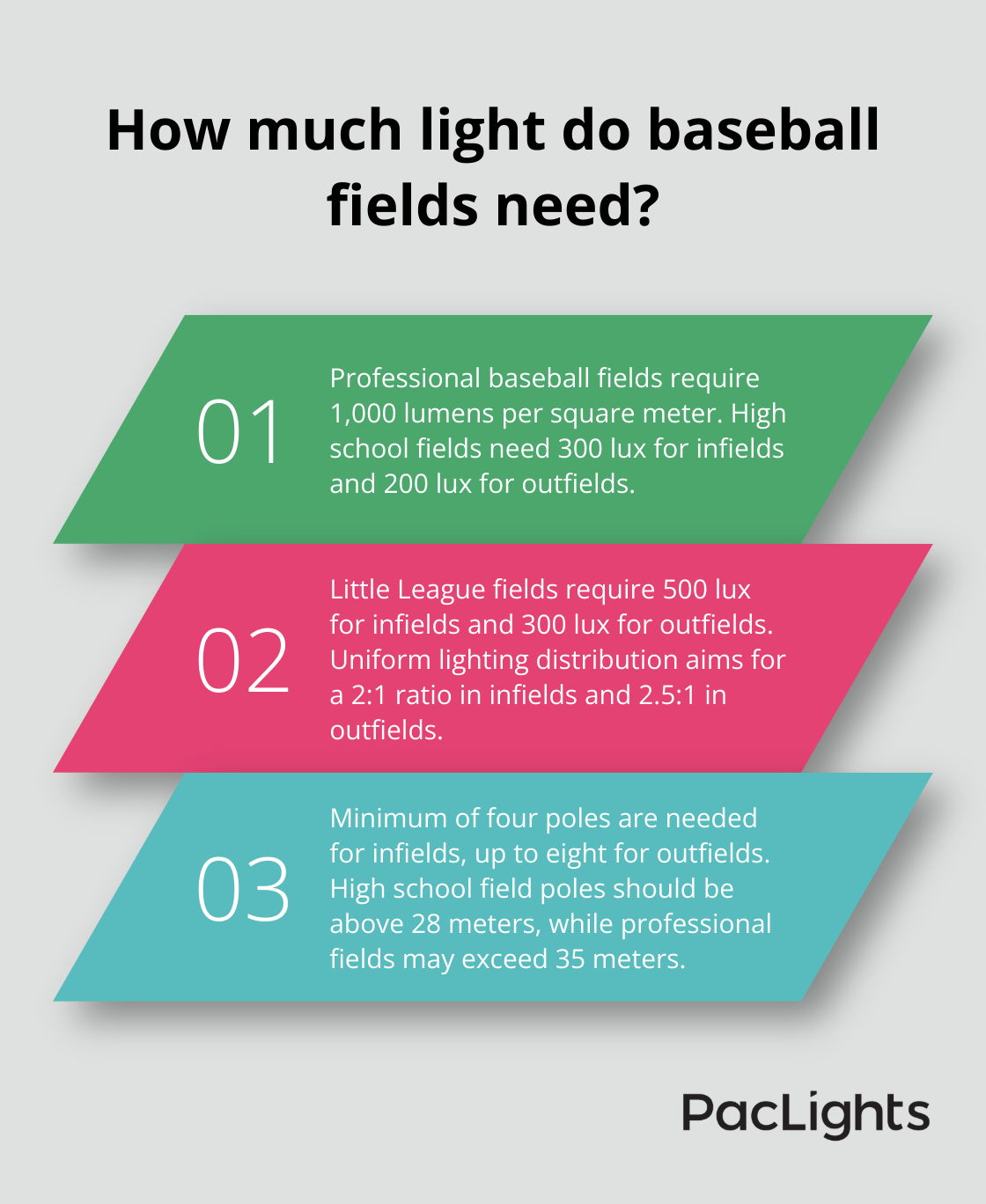
These standards ensure player safety, enhance performance, and provide an optimal viewing experience for spectators. When designing a lighting system, it’s important to consider the highest level of play that will occur on the field to meet all potential needs.
The Critical Role of Uniform Lighting
Uniform lighting distribution is paramount in baseball. Uneven lighting creates shadows and dark spots, making it difficult for players to track the ball and potentially leading to errors or injuries. The goal is to achieve a maximum-to-minimum illumination ratio of 2:1 for infields and 2.5:1 for outfields.
To achieve this uniformity, strategic placement of light fixtures is essential. A minimum of four poles for infields and up to eight poles for outfields are typically required (depending on the field size and competition level). The mounting height of these poles is equally important, with high school fields often requiring heights above 28 meters, while professional fields may exceed 35 meters to minimize glare.
Minimizing Glare for Player Safety
Glare reduction is a critical consideration in baseball lighting design. Excessive glare can impair a player’s ability to see the ball, particularly for outfielders facing the infield. To combat this, we recommend using fixtures with precise optical control and proper aiming techniques.
One effective strategy is to position lights at multiple angles, typically incorporating three to four light directions. This approach helps to model players properly and reduce disruptive shadows. Additionally, using fixtures with high-quality reflectors and lenses can help direct light more precisely where it’s needed, minimizing spill and glare.
Color Quality for Optimal Visibility
Color rendering and temperature specifications play a vital role in baseball lighting. The recommended color temperature for baseball lighting typically falls between 5000K and 5700K, providing a daylight-like appearance that enhances visibility.
The Color Rendering Index (CRI) is equally important. A CRI of 65 or higher is generally recommended for baseball, with some professional venues opting for even higher values of 90+ to enhance the visual experience (especially for televised games).
These color specifications directly impact how well players can see the ball against various backgrounds, from the sky to the stands. Proper color rendering can make the difference between a caught fly ball and a missed opportunity.
With these key lighting requirements in mind, let’s explore the essential components that make up an effective baseball field lighting system.
Choosing the Right Baseball Field Lighting Components
Fixture Selection for Baseball Fields
LED technology has transformed sports lighting, offering numerous advantages over traditional lighting sources like metal halide lamps due to its higher energy efficiency. For baseball fields, LED floodlights designed specifically for sports lighting are the top choice. These fixtures should have a luminous efficiency of at least 135-170 lm/W to ensure adequate brightness while conserving energy. Look for fixtures with high IP (water-resistant) and IK (impact-resistant) ratings to withstand harsh outdoor conditions and potential impacts from stray balls.
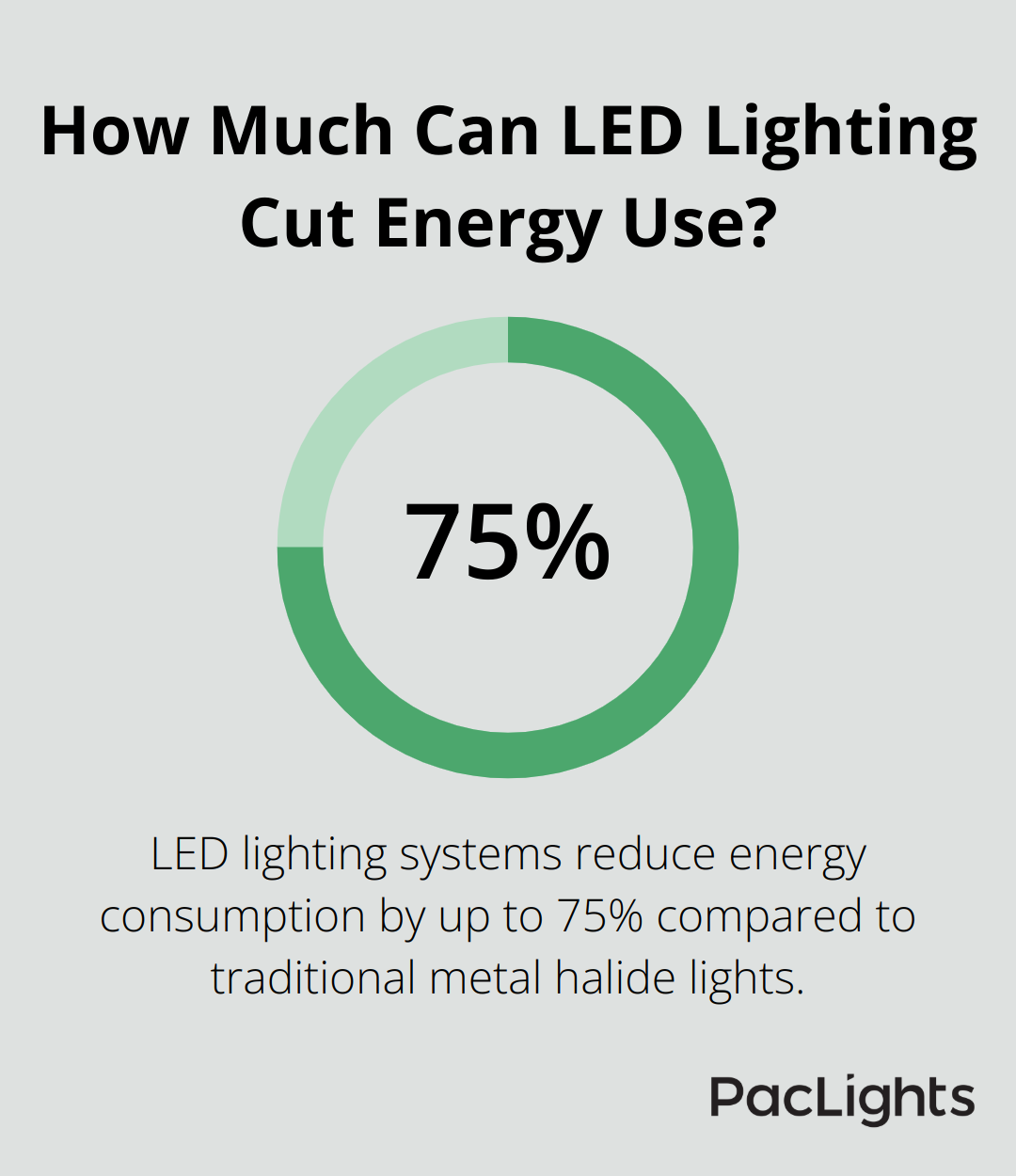
Modular design fixtures (like the Contender Sports Flood Light) provide flexibility in installation and maintenance. This type of fixture delivers uniform illumination across large areas, making it ideal for baseball fields.
Strategic Pole Placement and Mounting
Proper pole placement creates uniform lighting distribution. Most baseball fields require 4-8 poles strategically positioned around the field. The exact number and placement depend on the field size and level of play.
Mounting height plays a critical role. High school fields need poles at least 60 feet tall, while professional fields may require heights of up to 100 feet or more. Higher mounting points reduce glare and improve overall light distribution.
Energy-Efficient LED Solutions
LED lighting systems offer significant advantages over traditional metal halide lights. They reduce energy consumption by 50-75%, leading to substantial cost savings over time. LED fixtures also have a much longer lifespan, often exceeding 50,000 hours of operation. This longevity translates to reduced maintenance costs and fewer disruptions to field use.
When selecting LED fixtures, try to choose those with a color temperature between 5000K and 5700K to provide daylight-like conditions. Additionally, select fixtures with a Color Rendering Index (CRI) of at least 65 to ensure accurate color representation on the field.
Advanced Control Systems
Modern baseball field lighting should incorporate advanced control systems for maximum flexibility and energy savings. These systems allow precise dimming and scheduling, enabling you to adjust light levels based on specific needs or time of day.
Some control systems offer remote management capabilities, allowing facility managers to control lighting from a smartphone or tablet. This feature proves particularly useful for managing multiple fields or adjusting lighting quickly in response to changing weather conditions.
The selection and implementation of these key components create a baseball field lighting system that enhances player performance and improves spectator experience. The next section will explore specific lighting strategies for different areas of the baseball field, ensuring optimal illumination across the entire playing surface.
Tailoring Light for Every Corner of the Field
Infield Illumination: The Heart of the Action
The infield requires the highest level of illumination due to the fast-paced nature of play in this area. Professional fields need an illuminance level of 1,500 lux. High school fields operate effectively with 300 lux, while Little League fields should have 500 lux in the infield.
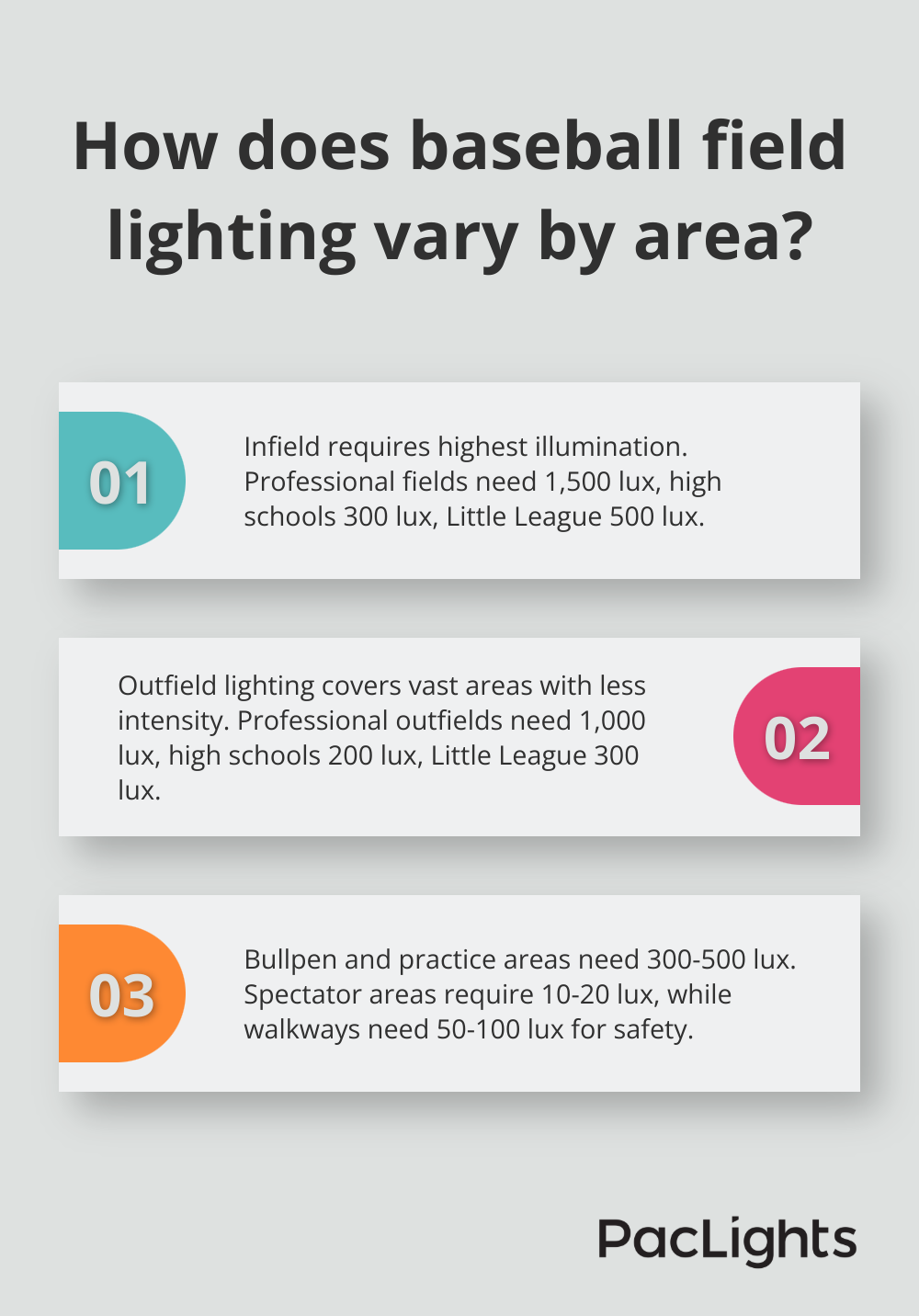
Focus on vertical illuminance. Players need to see the ball clearly as it travels through the air. Use a combination of front and back lighting to minimize shadows and create depth perception. This approach helps infielders track the ball more easily (whether it’s a line drive or a pop-up).
Position lights at multiple angles, typically incorporating three to four light directions. This strategy helps model players properly and reduces disruptive shadows. It is particularly effective for the infield area.
Outfield Lighting: Wide Coverage, Minimal Glare
Outfield lighting presents unique challenges due to the vast area that needs coverage. Professional outfields require about 1,000 lux, while high school fields can function well with 200 lux. Little League outfields should have 300 lux.
Provide uniform illumination across the entire outfield while minimizing glare that could impair players’ vision when looking towards the infield. Use fixtures with precise optical control and proper aiming techniques.
Use taller poles for outfield lighting (often exceeding 35 meters for professional fields). This height helps reduce glare and improves overall light distribution. Consider the trajectory of fly balls when positioning lights to ensure players can track the ball against the night sky.
Bullpen and Practice Area Lighting
The bullpen and practice areas are important for player warm-up and development. While they don’t require the same intensity as the main field, they still need adequate illumination for safe and effective practice.
Try to achieve illuminance levels of about 300-500 lux in these areas. Use fixtures that offer flexibility in terms of beam spread and direction. This allows for easy adjustments based on specific training needs or bullpen configurations.
Spectator and Walkway Illumination
The playing field is the main focus, but spectator areas and walkways also need proper lighting. Good illumination in these zones enhances safety and overall experience for fans.
Try to achieve an illuminance level of about 10-20 lux for seating areas. This provides enough light for comfortable viewing and safe movement without interfering with the field lighting. Walkways and stairs should have slightly higher illuminance (around 50-100 lux) to ensure safe navigation.
Use separate circuits for these areas. This allows for independent control, enabling you to adjust or turn off spectator lighting during game play if needed, while maintaining necessary illumination for safety.
Baseball lighting design combines complex elements to create the perfect playing environment. Illumination standards, uniform distribution, glare reduction, and color quality all enhance player performance and spectator experience. The strategic selection of fixtures, pole placement, and advanced control systems forms the foundation of an effective lighting setup.
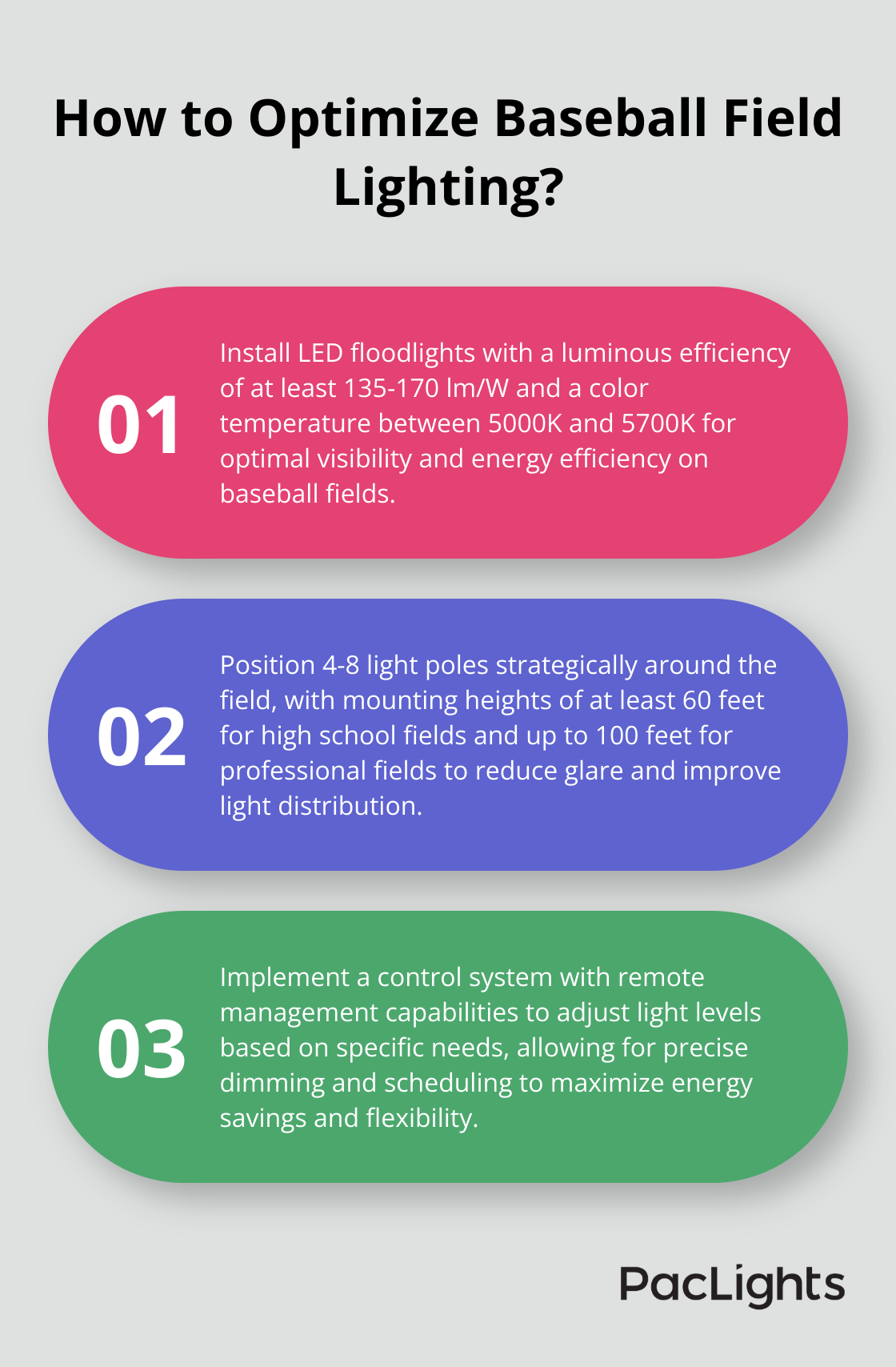
Professional lighting design balances energy efficiency, light quality, and specific league requirements. At PacLights, we offer comprehensive lighting solutions tailored to diverse industrial needs, including sports facilities. Our expertise helps achieve the best results in baseball field illumination.
The future of baseball field lighting promises advancements in LED technology and smart control systems. These innovations will improve play quality, enhance viewer experience, and contribute to more sustainable sports facilities. Professional baseball lighting design creates an environment where America’s favorite pastime thrives under the lights, night after night.


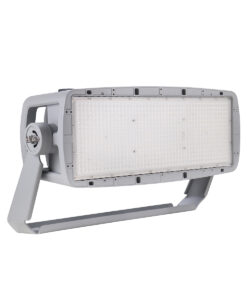
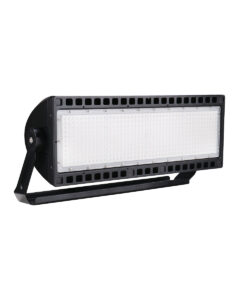
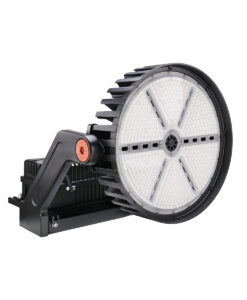
Disclaimer: PacLights is not responsible for any actions taken based on the suggestions and information provided in this article, and readers should consult local building and electrical codes for proper guidance.